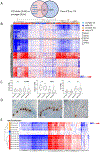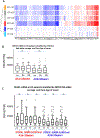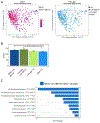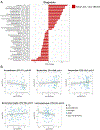Age-of-diagnosis dependent ileal immune intensification and reduced alpha-defensin in older versus younger pediatric Crohn Disease patients despite already established dysbiosis
- PMID: 30542108
- PMCID: PMC6375755
- DOI: 10.1038/s41385-018-0114-4
Age-of-diagnosis dependent ileal immune intensification and reduced alpha-defensin in older versus younger pediatric Crohn Disease patients despite already established dysbiosis
Abstract
Age-of-diagnosis associated variation in disease location and antimicrobial sero-reactivity has suggested fundamental differences in pediatric Crohn Disease (CD) pathogenesis. This variation may be related to pubertal peak incidence of ileal involvement and Peyer's patches maturation, represented by IFNγ-expressing Th1 cells. However, direct mucosal evidence is lacking. We characterize the global pattern of ileal gene expression and microbial communities in 525 treatment-naive pediatric CD patients and controls (Ctl), stratifying samples by their age-of-diagnosis. We show a robust ileal gene signature notable for higher expression of specific immune genes including GM-CSF and INFγ, and reduced expression of antimicrobial Paneth cell α-defensins, in older compared to younger patients. Reduced α-defensin expression in older patients was associated with higher IFNγ expression. By comparison, the CD-associated ileal dysbiosis, characterized by expansion of Enterobacteriaceae and contraction of Lachnospiraceae and Ruminococcaceae, was already established within the younger group and did not vary systematically with increasing age-of-diagnosis. Multivariate analysis considering individual taxa, however did demonstrate negative associations between Lachnospiraceae and IFNγ, and positive associations between Bacteroides and α-defensin expression. These data provide evidence for maturation of mucosal Th1 immune responses and loss of epithelial antimicrobial α-defensins which are associated with specific taxa with increasing age-of-diagnosis in pediatric CD.
Conflict of interest statement
Conflict of Interest:
The authors have no conflict of interest to declare.
Figures






References
-
- Gower-Rousseau C et al. Epidemiology of inflammatory bowel diseases: new insights from a French population-based registry (EPIMAD). Digestive and liver disease : official journal of the Italian Society of Gastroenterology and the Italian Association for the Study of the Liver 45, 89–94, doi:10.1016/j.dld.2012.09.005 (2013). - DOI - PubMed
-
- Meinzer U et al. Ileal involvement is age dependent in pediatric Crohn's disease. Inflammatory bowel diseases 11, 639–644 (2005). - PubMed
Publication types
MeSH terms
Substances
Grants and funding
LinkOut - more resources
Full Text Sources
Medical
Molecular Biology Databases

